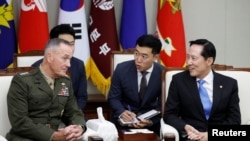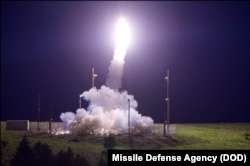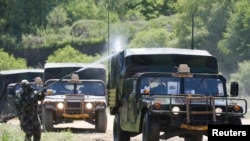The top U.S. general says the United States and its South Korean allies are working through “a number of technical issues” before the United States’ Terminal High-Altitude Area Defense system can be fully deployed on the Korean peninsula.
Joint Chiefs of Staff Chairman General Joe Dunford told reporters he and South Korea President Moon Jai-In “did not talk about the specific timeline” for THAAD’s full deployment during their meeting Monday in Seoul.
Secretary of Defense Jim Mattis and Secretary of State Rex Tillerson, in a joint op-ed published Monday in the Wall Street Journal, commended South Korea’s new government for “moving forward with the deployment of U.S. Terminal High-Altitude Area Defense.”
THAAD can shoot down short, medium, and intermediate-range ballistic missiles. Two of the system’s six launchers are fully operational, and President Moon ordered consultations on the possibility of deploying the final four launchers following North Korea’s intercontinental ballistic missile test on July 28.
The top U.S. general in Korea, General Vincent Brooks, says it would not take long for the final launchers to “be up and integrated.”
“We already have defense in place, so we are adding four additional launchers to those two that are already in place,” Brooks told reporters.
A U.S. Pacific Command senior official said the rest of the THAAD battery could be up in “days” once the deployment receives final approval.
THAAD’s ability to take out missile threats has proven 15 for 15 in tests conducted since 2005, when the system began operational testing.
The United States sees the system as a critical to protecting the 28,000 U.S. troops and 660,000 South Korean troops on the peninsula who would be called upon to fight should North Korea launch an attack on its southern neighbor.
Political analyst Bong Young-shik with the Yonsei University Institute for North Korean Studies said during Monday's talks, South Korean officials likely clearly conveyed to Dunford the risk of a possible U.S. preemptive military action against North Korea.
“It is a plain fact that if there be, god forbid, military conflict, a major one, between Washington and Pyongyang, South Korea will be the biggest victim. So entrapment into a military conflict between North Korea and the United States should be avoided by all means and [that] messaging is central to the nation," Bong said in Seoul.
Dunford next holds talks with military and political leaders in China, who have strongly opposed the deployment of THAAD to South Korea.
“China’s demand for the U.S. and South Korea not to deploy THAAD is unrealistic,” Mattis and Tillerson wrote in Monday’s op-ed. “Technically astute Chinese military officers understand the system poses no danger to their homeland.”









